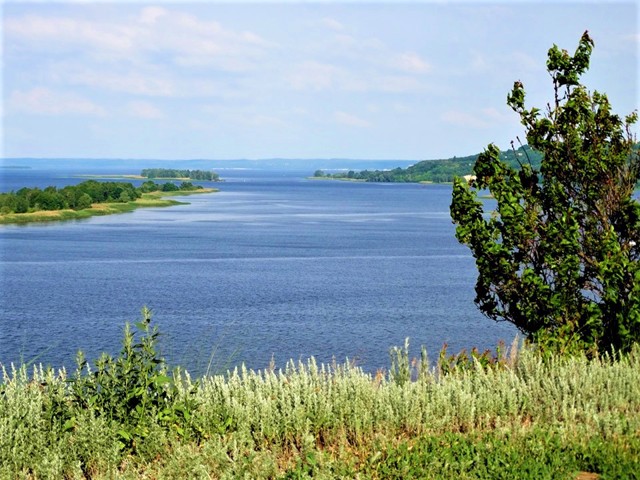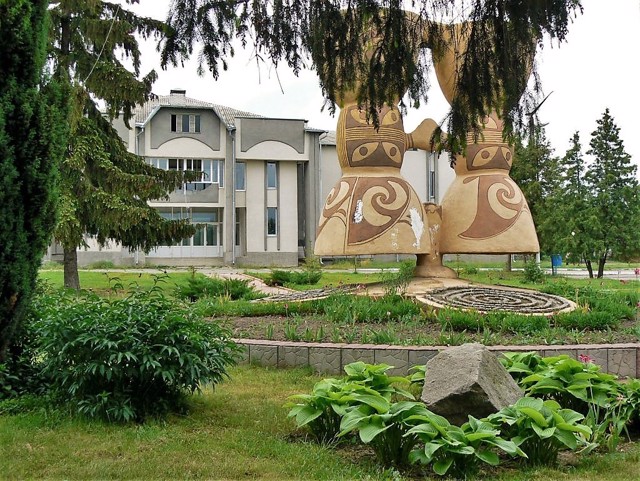Functional temporarily unavailable
General information about Rzhyshchiv
The picturesque town-pier Rzhyshchiv is located on the right bank of the Dnipro, at the confluence of the river. Lehlych, 70 km from Kyiv downstream.
The name most likely has a Polish origin either from "rzecz" (crowd), or from "vzhyshche" (marketplace).
Rzhyshchiv is known for archaeological finds related to the Trypillian culture (the sculptural park of the Trypillya period is located in the center, active excavations are being carried out on the southern outskirts of the city, in the Repnitsa gully).
For the first time, the settlement was mentioned as the Old Rus fortress Ivan-gorod in 1151, but already in 1241 it was destroyed by the hordes of Batyi. In Ivan Hill tract has preserved an ancient settlement and the ramparts of a later Polish fortre ...
The picturesque town-pier Rzhyshchiv is located on the right bank of the Dnipro, at the confluence of the river. Lehlych, 70 km from Kyiv downstream.
The name most likely has a Polish origin either from "rzecz" (crowd), or from "vzhyshche" (marketplace).
Rzhyshchiv is known for archaeological finds related to the Trypillian culture (the sculptural park of the Trypillya period is located in the center, active excavations are being carried out on the southern outskirts of the city, in the Repnitsa gully).
For the first time, the settlement was mentioned as the Old Rus fortress Ivan-gorod in 1151, but already in 1241 it was destroyed by the hordes of Batyi. In Ivan Hill tract has preserved an ancient settlement and the ramparts of a later Polish fortress. In 1506, King Sigismund I revived the Dnipro line of defense and granted Rzhyshchiv the Magdeburg Law.
For a long time the city belonged to the noble family of Voronychys, on whose initiative Orthodox churches and monasteries were built. On the territory of the Transfiguration Monastery in 1653, the first meeting of Hetman Bohdan Khmelnitsky with the Moscow embassy took place. The new citadel of Rzhyshchiv in the 18th century became the defensive Trinitarian Mosnastyr with the Church of the Holy Trinity, destroyed during the Soviet era. On the hill at the entrance to the city, there are the remains of the Lipki park of the Dolhoruky estate, where the Decembrists gathered. Then it became the property of the Fadeev family (their grandchildren were Olena Blavatska, Serhiy Vitte).
When creating the Kaniv Reservoir in 1972, several neighboring villages were flooded; on the opposite bank of the Dnipro, a half-flooded church was preserved.
Rzhyshchiv hosts the annual ethnic festival "Trypillya Kolo".
Мальовниче містечко-пристань Ржищів розташоване на правому березі Дніпра, при впадінні в нього річки Леглич, в 70 кілометрах від Києва нижче за течією.
Назва швидше за все має польське походження або від "ржеча" (натовп), або від "Вжище" (торжище).
Ржищів відомий археологічними знахідками, пов'язаними з трипільською культурою (скульптурний парк трипільського періоду знаходиться в центрі, активні розкопки ведуть на південній околиці міста, в балці Репниця).
Вперше поселення згадується як давньоруська фортеця Іван-город у 1151 році, але вже у 1241 році було зруйнована ордами Батия. В урочищі Іван-гора збереглося давнє городище та вали більш пізньої польської фортеці. У 1506 році король Сигізмунд І відродив Дніпровську лінію оборони та надав Ржищев ...
Мальовниче містечко-пристань Ржищів розташоване на правому березі Дніпра, при впадінні в нього річки Леглич, в 70 кілометрах від Києва нижче за течією.
Назва швидше за все має польське походження або від "ржеча" (натовп), або від "Вжище" (торжище).
Ржищів відомий археологічними знахідками, пов'язаними з трипільською культурою (скульптурний парк трипільського періоду знаходиться в центрі, активні розкопки ведуть на південній околиці міста, в балці Репниця).
Вперше поселення згадується як давньоруська фортеця Іван-город у 1151 році, але вже у 1241 році було зруйнована ордами Батия. В урочищі Іван-гора збереглося давнє городище та вали більш пізньої польської фортеці. У 1506 році король Сигізмунд І відродив Дніпровську лінію оборони та надав Ржищеву Магдебурзьке право.
Тривалий час місто належало шляхетському роду Вороничей, з чиєї ініціативи будувалися православні храми та монастирі. На території Преображенського монастиря в 1653 році відбулася перша зустріч гетьмана Богдана Хмельницького з московським посольством. Новою цитаделлю Ржищева в XVIII столітті став оборонний Тринітарський монастир з костелом Святої Трійці, знищений за радянської влади. На пагорбі при в'їзді в місто збереглися залишки парку "Липки" садиби Довгоруких, де збиралися декабристи. Потім вона перейшла у власність родини Фадєєвих (їх внуками були Олена Блаватська, Сергій Вітте).
При створенні Канівського водосховища в 1972 році було затоплено кілька навколишніх сіл, на протилежному березі Дніпра збереглася напівзатоплена церква.
У Ржищеві проходить щорічний етнічний фестиваль "Трипільське коло".
Сплануй своє перебування у Rzhyshchiv
What to see and where to go in Rzhyshchiv
Tourist attractions and museums of Rzhyshchiv

Dolhoruky-Fadyeyevs Estate "Lypky"
Natural object , Park / garden , Recreation area
Only the remains of the park and wonderful views of the Dnipro remained from the "Lypky" manor of the Dolhoruky-Fadyeyevs family estate in Rzhyshchiv.
In the 18th century, the manor belonged to Lieutenant General Adolphe Franzovich de Bandre du Plessis. His daughter Henrietta de Brande y Plessis married Major General Prince Pavlo Dolhoruky, who retired at the beginning of the reign of Paul I. After the Franco-Russian war in 1812, the future Decembrists Bestuzhev-Ryumin, the Muravyov-Apostol brothers, Prince Trubetsky visited the Rzhyshchiv estate of the Dolhorukys.
Princess Olena Dolhorukova, who married Andriy Fadyeyev, was born here. For some time they lived in Rzhyshchiv. Their grandchildren are the statesman Serhii Witte and the writer-theosophist Olena Blavatska (Blavatsky's mother, the writer Olena Fadyeyeva-Han, was born in Rzhyshchiv).
On a high cliff above the Dnipro, a part of the manor park "Lypky" with an old linden avenue has been preserved. This place is great for picnics.

Flooded Church
Temple , Architecture
During the creation of the Kaniv Reservoir in 1972, several villages on the outskirts of Rzhyshchiv were flooded. On the site of the former village of Husyntsi, the half-flooded Transfiguration Church with a bell tower has been preserved.
The church was built by the local landowner Husynsky in 1812 (according to other sources in 1822). The church in the Ukrainian Baroque style stood on a hill that turned into an island. In the summer, the church could only be reached by water, and in the winter it was possible to approach it by ice from the opposite bank of the Dnipro from Rzhyshchiv (a difficult approach through the forest).
For a long time, the church remained half-destroyed. In 2009, bank strengthening work began, raising the level of the island and reconstructing the church. A long bridge connects the island with the shore, where the Saint Nicholas Monastery-Hermitage was recently founded. In summer, you can organize a trip to the island to the flooded church by boat from the Rzhyshchiv pier.

Trypillya Culture Park
Monument , Park / garden
The Park of Trypillya sculpture is considered a business card of the city of Rzhyshchiv, which disputes with the village of Trypillia for the informal title of the capital of Trypillya culture.
Trypillya Park was created in the square in front of the building of the Rzhyshchiv City Council and the new cultural center in 2003-2004 at the initiative of the local authorities. The central element of the park is a large sculpture in the form of a Trypillya binocular vessel by the sculptor Anatoliy Haydamaka. This ritual vessel also became the central element of the new coat of arms and the main symbol of Rzhyshchiv.
The park also features female statuettes and other enlarged Trypil figures by sculptors Mykola Bilyk, Mykola Sivak, Volodymyr Sholudko and others.

Rzhyshchiv Archaeological and Local Lore Museum
Museum / gallery
Rzhyshchiv Archaeological and Local Lore Museum is housed in an original brick building of the late XIX - early XX centuries downtown.
The exposition is based on archaeological materials found during excavations in Rzhyshchiv.
The first hall presents archeological finds of different cultures: Trypillya, Chornoliska, Zarubynetska, Chernyakhivska and Ancient Rus.
The local lore hall shows Rzhyshchiv of the XVI-XX centuries, significant historical events are noted: the creation of the Rzhyshchiv Cossack Hundred, the meeting of the Hetman's Council Bohdan Khmelnytskyi and others.
Ethnographic material gives an idea of the life and way of life of peasants and burghers of the XVIII-XX centuries, their beliefs, crafts, clothing, everyday life.
Separate exhibitions of the Rzhyshchiv Archaeological and Local Lore Museum are dedicated to the Holodomor of 1932-1933 and the events of World War II.
The exhibition hall exhibits from the museum and the works of folk artists and craftsmen from Rzhyshchiv and Kyiv region.

Holy Trinity Church
Temple , Architecture
The Holy Trinity Church in Rzhyshchiv was built in 1853-1860 on the site of an old wooden church known since the 17th century.
The initiator of the construction of the stone temple was Countess Dzyalynska from the ancient Rzhyshchiv family of Voronychs.
In the architecture of the Trinity Church, the style of classicism is consistent with the features of the so-called diocesan architecture of the second half of the 19th century.
On the north wall of the church, frescoes from the 19th century have been preserved.
Reviews Rzhyshchiv
Geographical information about Rzhyshchiv
| {{itemKey}} | {{itemValue}} |
|---|---|
| Region |
Kyiv |








